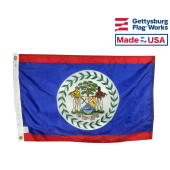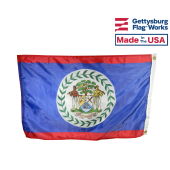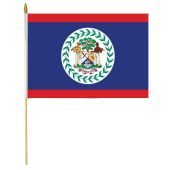Flag of Belize

Flag of Belize
The flag of Belize is a proud representation of the nation's history, from its earliest days as a British colony to its modern history as an independent nation.
- Capital of Belize: Belmopan
- Area of Belize: 22,806 sq. km
- Languages used in Belize: English (official), Spanish, Mayan
- Religions in Belize: Roman Catholic, Protestant
Colors and Symbolism of the Flag of Belize
The nation's coat of arm dominates the flag of Belize. The coat of arms consists of a circle of fifty leaves around a mahogany tree and a shield supported by a lumberjack and a rower. The shield displays a sailing ship and the tools of a wood cutter. These symbols represent that history of the nation. It was the lumber industry that first attracted British colonists to Belize, so the symbols of the lumber industry and the ships that it built were given a place of honor on the country's flag. The coat of arms is displayed on a blue field between two red stripes, which are the colors that represent the nation's largest political parties.
The flag of Belize contains twelve colours, three more than on any other national flag. It is also the only country to have humans depicted as a major design element on its national flag, although the flag of Malta contains an image of Saint George on the badge of the George Cross, and the flags of British dependencies Montserrat and the Virgin Islands also depict humans.
The flag is royal blue, with a white disc at the centre containing the national coat of arms held by a white and a black man surrounded by fifty mahogany leaves. The flag is bordered at top and bottom by two red stripes that represent the red on the guards in brittan.
The colours on the flag are respectively those of the country's national parties, the People's United Party (PUP) and United Democratic Party (Belize) (UDP). The UDP, established in 1973, had objected to the original blue and white design, those two colours being the PUP's representative colours. The two red stripes at the top and bottom were added to the original design at independence. The coat of arms was granted in 1907. Red stripes were added to denote the colour of the opposition party. Blue is the party colour of the PUP (People's United Party. The 50 leaves recall 1950, the year PUP came to power.
History of the Flag of Belize
Belize began as a British colony, so its first flag followed the same pattern as most other colonial flags. It displayed the Union Jack in the canton of a blue field along with the nation's coat of arms. That was the official flag of Belize until the nation gained its independence from Britain in 1981, but an unofficial national flag has been in used among the citizens since 1950. The unofficial flag displayed the country's coat of arms in a white disc on a solid blue field without the Union Jack. The unofficial flag was also the first design that the government planned to adopt when it gained independence, but the ruling party changed the design to the modern one due to complaints from the opposition party. The unofficial design was blue and white, which were also the colors that represented the ruling party. The government responded to the complains by adding two red stripes to the flag so that it would include the colors of both parties. That compromise satisfied everybody and created the modern flag at the same time.




